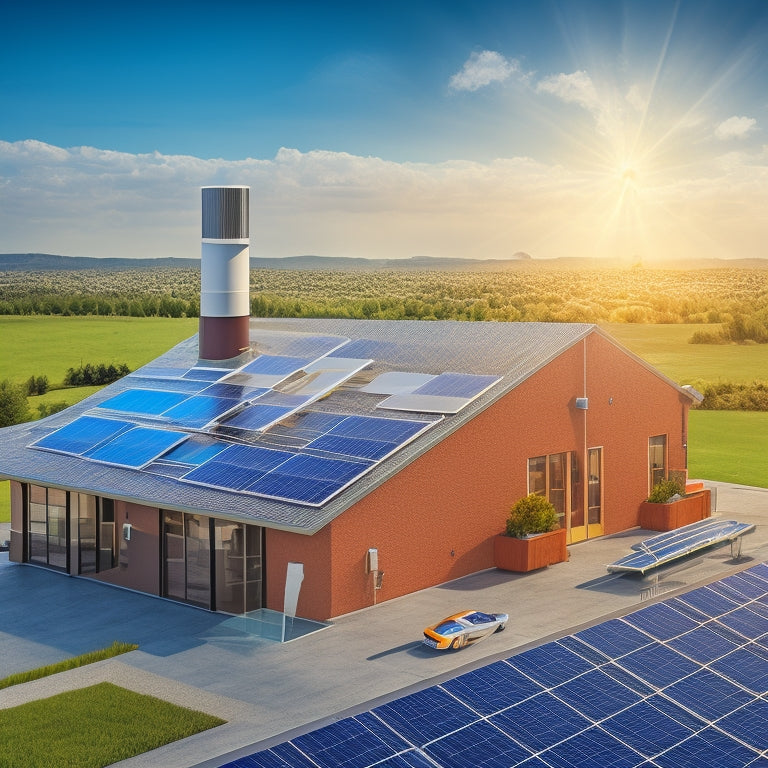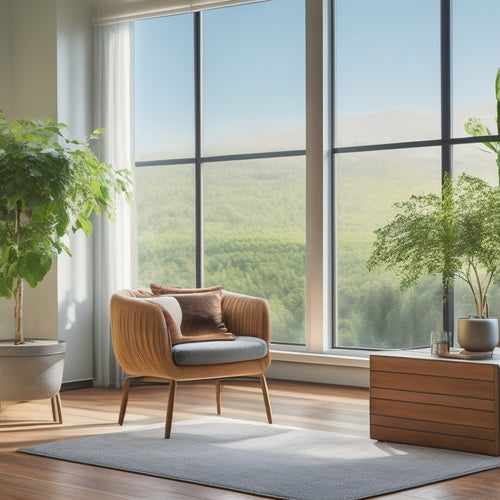
Why Proper Roof Ventilation Slashes Energy Bills
Share
By incorporating proper roof ventilation strategies into your home design, you can slash your energy bills by up to 20% during peak summer months. This is because roof ventilation reduces the burden on cooling systems, allowing natural airflow to decrease humidity and prevent mold growth. Strategically placed vents facilitate warm air exit, improving indoor comfort, while integrated insulation and ventilation systems lower energy consumption. As you investigate the world of roof ventilation, you'll uncover more about how it works in tandem with passive ventilation, power ventilation systems, and radiant barriers to maximize energy efficiency and create a healthier, more comfortable living space.
Key Takeaways
- Proper roof ventilation reduces heat gain in summer, decreasing the load on cooling systems and resulting in significant energy savings.
- Effective ventilation systems remove hot air, reducing the temperature in attic spaces and minimizing the need for air conditioning.
- Well-designed ventilation strategies allow for natural airflow, decreasing humidity and preventing mold growth, which can lead to energy-wasting repairs.
- Balanced ventilation systems, including soffit and ridge vents, facilitate a consistent flow of fresh air, reducing the burden on HVAC systems and energy consumption.
- Strategically integrated insulation and ventilation systems can lower energy bills by up to 20% during peak summer months.
Passive Ventilation Strategies
Since heat naturally rises, passive ventilation strategies focus on creating pathways for warm air to escape from your attic space, reducing the burden on your cooling system and subsequently, your energy bills.
By incorporating natural airflow principles, you can create an effective ventilation system that works with nature, not against it. This approach allows warm air to rise and exit through strategically placed vents, reducing the humidity that can lead to mold and mildew growth.
In fact, utilizing sustainable station designs can also improve energy efficiency in buildings. Additionally, incorporating eco-friendly features like green roofs and rainwater harvesting systems can enhance the overall energy-saving benefits.
Power Ventilation Systems Work
Your roof's ventilation system gets an enhancement with power ventilation systems, which use electric-powered fans to extract hot air from your attic space.
These active ventilation systems provide a more efficient way to remove heat, especially in climates with hot summers or during periods of high humidity. By leveraging solar-powered charging solutions and reducing our reliance on traditional power sources, we can create a more sustainable future.
Additionally, integrating energy storage systems can improve charging efficiency and boost grid resiliency. By installing power ventilation systems, you can greatly reduce energy consumption and lower your energy bills.
In fact, you can expect energy savings of up to 20% during peak summer months. With power ventilation, you'll enjoy a cooler attic, reduced moisture buildup, and a more comfortable living space.
Plus, these systems are designed to work in tandem with passive ventilation strategies, ensuring ideal airflow and maximum energy efficiency.
Radiant Barrier Installation Tips
When installing a radiant barrier, you'll want to guarantee proper barrier placement to maximize its energy-saving potential. This means positioning the barrier on the underside of your roof rafters, typically in the attic space, to effectively reflect heat rather than absorb it.
By integrating the barrier with your existing insulation, you'll create a thorough system that reduces heat gain in the summer and heat loss in the winter.
Enhancing your solar panel array design, including factors such as tilt, sizing, and orientation, can also greatly impact energy production solar panel array.
Regular monitoring and maintenance of your system can help identify areas for improvement and guarantee peak performance.
Proper Barrier Placement
You're about to install a radiant barrier in your attic, and proper placement is essential to maximize its effectiveness.
Regular tracking of energy production enables identification of inefficiencies and cost-saving opportunities Energy Production Monitoring, and verifying your radiant barrier is installed correctly can help you achieve these goals.
Confirm the barrier is installed directly on top of the attic insulation, with the reflective side facing upwards. This allows the radiant barrier to effectively block heat gain during summer and heat loss during winter.
When installing baffles, make sure to maintain a 1-inch gap between the baffle and the roof deck to prevent air leakages and thermal bridging.
Additionally, confirm proper vent sizing based on your roof pitch to maintain adequate airflow.
Effective Insulation Integration
Properly integrating your radiant barrier with existing attic insulation is vital to achieving ideal energy efficiency.
You'll need to take into account the type of insulation you have, as different materials have varying thermal resistance. Implementing sustainable fuel options, such as electrification and biodiesel, can also reduce greenhouse gas emissions Sustainable Fuel Options.
Verify air sealing is done correctly to prevent heat loss and moisture accumulation. Conduct an energy audit to identify areas of improvement in your attic space.
In regions with high climate impact, it's essential to choose the right insulation and ventilation design. Building codes may vary depending on your roof type, so be certain to check local regulations.
Soffit Ventilation Benefits Explained
When you install soffit vents, you're creating an intake pathway for fresh air to enter your attic space, which improves air circulation and helps reduce moisture buildup.
This, in turn, increases energy efficiency by reducing the load on your HVAC system.
Improved Air Circulation
They say a well-ventilated attic is a happy attic, and it's hard to argue with that.
When you have proper soffit ventilation, you're ensuring improved air circulation in your attic space. This means you're optimizing airflow mechanics, which directly impact thermal comfort in your living space.
With increased airflow, heat can escape more efficiently, reducing the load on your HVAC system. You'll notice a significant difference in your energy bills as your system works less hard to maintain a comfortable temperature.
This, in turn, gives you more freedom to enjoy your home, without worrying about the cost of staying cool or warm.
Reduced Moisture Buildup
Frequently, homeowners overlook a vital aspect of roof ventilation: soffit ventilation's role in reducing moisture buildup.
You may not realize it, but soffit vents play a vital role in humidity control by allowing air to enter your attic space from the underside of your roof. This airflow helps to remove excess moisture, preventing it from accumulating and causing damage.
Without proper soffit ventilation, moisture buildup can lead to mold growth, wood rot, and other issues. By installing soffit vents, you're taking a proactive step towards mold prevention and ensuring a healthier, more durable roof.
Increased Energy Efficiency
During the hot summer months, soffit ventilation plays an essential role in increasing energy efficiency by allowing hot air to escape from your attic space.
This allows your air conditioning system to work more efficiently, reducing the load and resulting in significant energy savings.
By removing heat from your attic, you'll notice a cost reduction in your energy bills.
In fact, studies have shown that proper roof ventilation can reduce energy consumption by up to 20%.
This means you'll enjoy a cooler home while keeping more money in your pocket.
Whole House Ventilation Systems
Most homes rely on whole house ventilation systems to provide a consistent flow of fresh air, reducing the risk of moisture buildup and indoor air pollution.
You can choose from various ventilation types, including supply, exhaust, and balanced systems, each with its own strengths and weaknesses.
Energy recovery ventilation systems, which exchange heat and moisture between incoming and outgoing air, are particularly effective at reducing energy bills.
By installing a whole house ventilation system, you can guarantee a healthy indoor environment while minimizing energy losses.
This is especially important in tightly sealed homes, where air stagnation can lead to mold growth and poor indoor air quality.
Insulation and Ventilation Synergy
As you've invested in a whole house ventilation system, you're likely aware of the importance of maintaining a healthy indoor environment.
Insulation and ventilation cooperation is essential to achieving this goal. Effective insulation materials, such as fiberglass, cellulose, or spray foam, work in tandem with ventilation types like soffit, ridge, or power ventilators to regulate heat transfer and airflow.
When insulation and ventilation systems are properly integrated, they create a balanced environment that reduces heat gain in summer and heat loss in winter. This balance enables your ventilation system to operate more efficiently, reducing the load on your HVAC system and ultimately slashing your energy bills.
Frequently Asked Questions
Can I Install Roof Ventilation Myself or Do I Need a Professional?
You can attempt a DIY installation, but it's essential to understand the different ventilation types, such as soffit, ridge, and power ventilators, to make certain a proper setup, or consider hiring a professional to assure a job well done.
How Often Should I Inspect and Clean My Roof Ventilation System?
You should inspect your roof ventilation system annually, checking for debris and animal infestation, and clean it every 3-5 years using gentle pressure washing and soft-bristled brushes to maintain ideal airflow and energy efficiency.
Do Roof Vents Affect the Structural Integrity of My Roof?
You're wondering if roof vents compromise your roof's structural integrity. The answer is, it depends on the ventilation type and insulation impact. Properly installed vents won't weaken your roof, but inadequate or misplaced ones can lead to structural issues, so guarantee a professional installation.
Can Roof Ventilation Help Reduce Moisture and Mold Growth?
You'll be thrilled to know that proper roof ventilation plays an essential role in moisture control, effectively preventing mold growth by allowing warm air to escape, reducing condensation, and creating a dry environment that's inhospitable to mold development.
Will Roof Ventilation Make My Roof More Susceptible to Animal Infestation?
You're right to wonder if roof ventilation will attract unwanted critters; however, proper vent placement and understanding animal behavior can minimize the risk, ensuring you enjoy the benefits of ventilation while keeping your roof pest-free.
Related Posts
-

Why Vertical Gardens Reduce Home Energy Consumption
By incorporating a vertical garden into your home design, you'll reduce energy consumption through natural insulation...
-

7 Smart Air Purification Hacks for Energy-Savvy Homes
You can notably improve your indoor air quality while minimizing energy consumption by implementing strategic air pur...
-

10 Best Sustainable Waste Management Solutions for Green Homes
You're likely unaware that the average green home generates over 2 kilograms of waste daily, but with the right susta...


